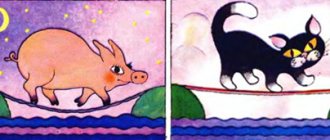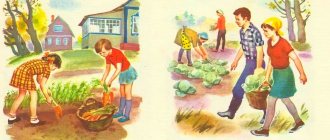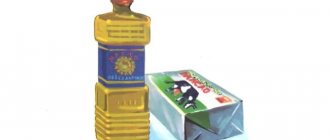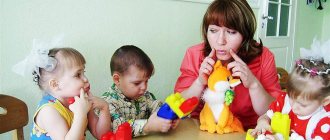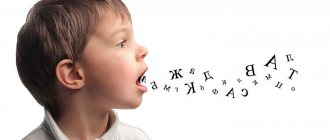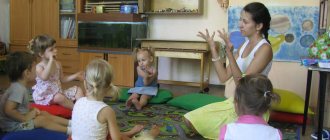The topic “Toys” must be used during speech therapy classes with preschoolers aged 2-7 years. Of course, the best pictures for children in kindergarten are Toys, which are specially selected for educational activities.
In the lexical material on this topic, several important “steps” can be identified, elements that must be mastered by preschoolers:
- The very generalizing concept of “toys”.
- Various names of items used for different types of games (story-based, action, etc.).
- General features and properties of toys, as well as their differences from other items.
- Ways to use certain toys.
- Features of their device.
- An idea of the material from which game items are made.
Here is a minimum list of words on the topic of toys for children that should be introduced into the active vocabulary of preschool children:
- Names of toys and their parts (nouns):
bear, bunny, dog, doll, car, ball, top, construction set, matryoshka, pyramid, head, torso, arm, leg, muzzle, paw, tail.
- Characteristics of items for games (adjectives):
* it is useful to teach them with children in pairs, comparing the properties of different toys.
Big - small, round - square, soft - hard, smooth - rough, fur - plastic, iron - wood, new - old.
- Various actions that can be performed with these objects (verbs):
Roll, carry, build, swing, dress, bathe, feed, wear, buy, lose, find, sew, play, collect.
Drawn pictures
For the formation of a passive vocabulary, pictures for children depicting various toys are of great importance. It is very good if they are presented in a wide variety, this allows you to offer the child many different speech exercises and activities.
For speech therapy games, it is much more convenient to use cards rather than real objects. Sorting and describing images not only contributes to children’s speech development, but also improves them:
- visual-figurative thinking;
- RAM;
- attention.
Of course, it is very difficult to draw such pictures yourself; it is better to find ready-made ones selected by professional speech therapists.
The use of subject pictures and plot pictures in the development of coherent speech in children
Zemtsova Ekaterina
The use of subject pictures and plot pictures in the development of coherent speech in children
«The use of subject pictures and plot pictures in the development of coherent speech in children»
The first three years of life are a period of intensive physical and psychological development of children . Guided by the education program in kindergarten, we form in children correct elementary ideas and concepts about the surrounding reality, develop speech , contribute to the formation of positive character traits and the development of moral and aesthetic feelings.
Children become familiar with the life around them mainly through direct communication with adults, observation of objects , and various activities in everyday life, in games and in class. For children to develop correct ideas , pictures are also of great importance . We believe that they help clarify and consolidate the knowledge acquired in the process of direct acquaintance with the surrounding life, and develop the language and thinking of children . Looking at pictures evokes certain feelings and emotions in a child , promotes the formation of love for loved ones - mother, father, grandmother, and respect for the work of adults. During classes we show object pictures - these are images of animals, plants, toys and various household items . The pictures show objects of different sizes (big bunny, small, colors (tower red, blue, in various actions: sleeping, eating, sitting (cat, singing, pecking (rooster, roaring, grazing (cow))
etc. To teach
children to pronounce accessible sound combinations and words, we show pictures and images of animals (a dog barks, a cow roars, a duck quacks, etc.)
.
The series of story pictures includes pictures with simple and more complex content.
Pictures with simple content are images of people who are acting (a girl washes herself, plays with a doll, washes dishes, a grandmother sews, a mother does laundry, a mother dresses her daughter).
Pictures with a more complex plot depict several objects in various interactions and relationships (mother and daughter on a walk, children congratulating grandfather on the holiday, children in the forest). This series also includes those pictures that depict the work of children and adults (children planting, watering flowers, dad driving a harvester)
.
When working with children of our age (early age), we use subject pictures and story pictures . Some of them are shown in class, others are given for viewing in free time. We select them depending on the program objectives, age and level of development of the children
Coloring pages
To conduct classes on the topic “Toys” it is also very useful to use thematic coloring books. They help the child not only learn and remember all kinds of names of objects for games, but also practice using a large number of descriptive adjectives (in descriptions of various colors and materials). A correctly selected coloring book is a real helper for speech therapists and parents!
Conversations based on pictures, rules of work
Working from a picture can be interesting and fun. You shouldn’t immediately imagine a situation where a poor child sits and listens to an adult’s monotonous monologue. No! Speech work with pictures can be very exciting!
Diversity
Replenish your home file cabinet not only with standard subject and subject pictures. Pay attention to hanging calendars, posters, postcards, clippings from magazines and newspapers, books, tabletop printed lotto cards. Be sure to classify them, arrange them by topic, purpose, frequency of use. Organize a competent storage system. To familiarize yourself with one object (subject), use different pictures so that the child can understand and see all the diversity of our world.
All children love their own photos or photos of their life, situations and events from it. Use personal photographs whenever possible: toys, animals, loved ones, etc.
Graduality
When working with pictures, consider the principle of gradualism - do not introduce subject pictures before subject ones. First, we gradually introduce the baby to what he sees, hears, and what is often present in his life. The content of the pictures becomes more complex as the child grows and his ability to absorb a greater flow of information. If he is already familiar with domestic animals separately, then you can take stories with events taking place on a farm, in a village, at home with tame animals. Offer subjects in a logical relationship relative to each other after 3-4 years, not earlier.
Consolidation and connection with reality
Always repeat the material you have covered and apply it in everyday life, put it into practice if possible. Create a learning situation in its ordinary course, at any appropriate moment. Have a connection to reality to give meaning to what you study.
Creativity
Color conversations based on pictures with your emotions so that the child will better remember, understand, and apply the material. The better you can captivate him, the stronger the results will be. Be creative when learning. An adult must choose a bright and individual style of presenting information - a style that will captivate the child!
Child's interests
Use the child's main interests as a basis, and give less attractive material in smaller portions, unobtrusively and carefully. Do not forget about his capabilities and do not demand more than he is capable of. Do not be tied to age criteria in this matter: someone at 2 years old speaks perfectly in sentences (my eldest daughter), and someone is just learning to correctly use facial expressions and gestures to answer (the youngest is special - Anyutka).
Number of pictures
We always start with one subject picture, then we consider and discuss two, three or more. First we teach him to recognize him by name, point him with his finger, then ask him to name him himself (to the extent possible). When a child recognizes, shows, and names more than 3-4 pictures, you can teach him to classify them based on the search for a common feature(s). Subject pictures are also introduced gradually, starting with one and increasing the number to 3-4 (sometimes up to 6).
Remember! Don’t just let your child play with visual material in his free time. He may become fed up with the images and lose interest, which will complicate the process of your interaction in home lessons.
I made an exception and used pictures that were interesting to Anyuta only in the most difficult situations, for example, when undergoing rehabilitation procedures, when it was necessary to divert her attention from pain. Sometimes they took them with them in case I knew that she would have to spend a lot of time waiting, that is, bored and going crazy. In order to avoid inappropriate behavior and negative emotional reactions, I “sacrificed” valuable visual material, but this was outside the walls of the house.
Conversations on subject pictures
An object picture teaches the child to associate words with objects and name them, and later move on to their verbal description. To achieve this, we act according to plan.
- Let's get acquainted with the subject picture. Let the child look at what is depicted. We name the object and move our finger, and then his, along the contour - this action includes several analyzers that process information from the outside.
- We focus on the main points. We definitely call them names. You can build a conversation in the form of affirmative sentences; it is not forbidden to ask a question and answer it yourself, coloring this process emotionally and intonationally.
- It is advisable to have on hand the item shown in the picture - this will help you better assimilate the knowledge gained.
This is how we work with children aged 0 to 1-1.5 years. There are no age restrictions for developmental disabilities.
Example. Take a picture of a pyramid. The child sits on your lap (babies love skin-to-skin contact). If he prefers a distant position, do not insist on close interaction - let him take a place that is convenient for him. We show the picture and say: “Here is a pyramid. It is a toy. She has a lot of rings. Let's build a pyramid! You can list the colors, but then the picture should show a toy with 3-4 rings, no more. Let's take a real pyramid and look at it together. Let's talk about all of the above. You can disassemble and reassemble it.
Possible set of phrases in the game. Look what a pyramid! She has rings. The ring is round. Let's take off the rings. We dismantled the pyramid. Now let's put it together. This is a blue ring, and this is red, this is yellow, and this is green. We have assembled a pyramid! Well done!
Be sure to let your baby play with it: knock it on different surfaces, scatter the rings and try to collect it, smell it, feel it, lick it. Don't forbid him to explore the toy from different angles. Then return to the picture and say: “There is also a pyramid in the picture!”
After 1-1.5 years, the child learns to look at more than one picture, as well as listen to information about it. We continue to introduce him to the depicted objects, if possible, give him a real analogue from everyday life, at the same time we teach him to point with a finger and name them (first onomatopoeia, then lightweight words of one or several syllables). When the baby can already name the object, we try to compose short phrases: this is a pyramid, this is a bright pyramid, this is a dress, this is a blue dress, this is a car, the car is moving (beep), etc.
By the age of 2, you can teach your child not only to recognize an object and briefly talk about it, but also to perform simple actions with them (give me a car, take a red apple, show a yellow bear). In this version, the pictures are laid out in front of the baby (no more than 4 pieces).
By this age, we are gradually introducing classifications that include various household items, animals, people, transport, natural phenomena, plants and other objects found in life. The preschooler learns to identify images that are similar/different in color, size and shape, to look for generalizing features, and generalizing words are introduced. Instead of simplified words, correct names are practiced.
Games
With “Toys” pictures you can conduct many simple and effective speech therapy activities aimed at developing the speech of preschool children. Here are some examples of such games:
Name the pictures
The development of children's speech is facilitated by naming the various toys depicted on the cards. It is important to choose the most realistic drawings, this helps the child quickly recognize this or that object. Such pictures of toys for children must certainly be bright and attractive in appearance.
What's missing here?
The popular logic game “Odd Four” can also be used in speech therapy classes. During it, children are offered four images, three of which can be called in one word (“toys”), and one cannot; this card is selected from other categories (vegetables, plants, animals, transport, etc.). This game helps to enrich and activate passive vocabulary, and also perfectly trains the attention and thinking of preschoolers.
Which? Which? Which?
Show your child one picture at a time from the set of “Toys” cards and ask him to list the properties of the object depicted on it. For example: a doll - new, elegant, plastic, curly, blue-eyed, big, new, etc. If you have pictures from the Toys for Children series on a transparent background, then it is better to use them in this game.
Call me kindly
This game is great for developing the skill of using diminutive suffixes on nouns. An adult shows children 4 years and older toys (in pictures or real ones) and asks them to name them affectionately. Examples:
- doll - doll; - ball - ball; - bear - bear; - elephant - elephant; - hare - bunny; - car - machine; - jump rope - jump rope.
For children of senior preschool age 6-7 years old, you can conduct a complicated lesson: ask them to remember the names of toys that are used only in an “affectionate” form. (top, pyramid) or do not have it at all (spinning top, hoop, train, clown, etc.).
One-many
Teach your child not only to name toys one by one, but also to find one or another of them in a group of similar/identical images. Example:
ball - ball doll - dolls cube - cubes ball - balls.
Detectives
Another simple and exciting game that will help your child quickly learn the names of a large number of toys. As visual material for it you can use:
- Pictures;
- real objects for games;
- video materials.
First you need to show four different pictures with images of toys, and then hide (close) one of the cards. The baby must remember and name what is missing.
Guess what color
Invite your child to name the color of the toy you show him. You need to start with basic colors, then you can add more complex options, with shades (bright red, scarlet, dark green, light pink). During this game you can also reinforce the concepts
- bright; – multi-colored; - transparent; – multi-color.
Whose toy is this?
This exercise allows you to teach a preschool child how to coordinate nouns (names of toys) with personal pronouns. You show your child a picture and ask: “Whose is this?” Possible answers:
my (dog, spinning top, pyramid) my (ball, elephant, bunny, clown) my (lotto, dominoes) my (cubes, balls)
Who's doing what?
This game allows you to train the skill of agreeing a noun with a verb. Show your child pictures of toys (singular and plural, pairs) one at a time and ask the question: “What is this? What is he doing? Possible answers:
the doll is sleeping - the dolls are sleeping the parsley is sitting - the parsleys are sitting the bunny fell from the shelf - the bunnies fell from the shelf the top is spinning - the tops are spinning the ball rolled away - the balls rolled away the car broke down - the cars broke down the bear is sleeping - the bears are sleeping
The large picture “Toys for Children” can be used for a similar activity with several kids at once, in a group or subgroup.
What toy?
This fun game helps children learn the rules of noun-adjective agreement quickly and easily. Ask your child to come up with as many characteristics as possible for the toy whose image is in your hands. It is best to play this game among several children or in an adult-child pair. Try to avoid repeating adjectives; it is important to name as many different words as possible.
Example:
The horse is wooden, new, beloved, comfortable, hard, smooth, brown. Elephant - purple, soft, big, sad, big-eared.
Shop
The usual game of “shopping” can be slightly modified and effectively used to develop the speech of children in the senior and preparatory groups of kindergarten. Invite the children to choose a card from the “Toys” set, i.e., “make a purchase.” Then the boy or girl goes to the window and chooses a “purchase”. The child must accompany his actions with a correctly constructed complete sentence, in which he must name the selected object and several of its characteristics (color, material, size and other features). This exercise helps enrich children's active vocabulary and develop their imagination.
Example:
1. I want to buy a big yellow ball. 2. I want to buy a bright red cube. 3. I want to buy an elegant little doll. 4. I want to buy a set of wooden blocks in a box.
The picture Toys for Children on a transparent background is very suitable for this game, although ordinary cardboard cards can also be used.
Lesson 1
Subject.
Development of coherent speech Purpose: learning to retell; expansion and activation of vocabulary; formation of an internal retelling plan; development of attention, memory, logical thinking.
Equipment:
magnetic board (typesetting); subject picture “Winter” and subject pictures: sun, sparrows, snowdrifts, icicles, wind; card with exclamation mark
Note. Teachers should supplement the set of pictures with a card with an exclamation mark, which will indicate sentences reflecting the assessment of events and attitude to what is happening. For example:
Wait, spring, your time has not come yet! “Come to us, Masha,” they shouted, “let’s play with the boat together!” and so on.
Progress of the lesson
The teacher, attaching pictures from top to bottom, one under the other, to the magnetic board (typesetting board), reads the text:
Winter does not want to leave, does not give way to spring. During the day, the sun warms everything around with its bright warm rays. Sparrows chirp joyfully. The snowdrifts darken and settle. Long icicles are crying, hanging from the roofs. But by night the cold north wind will freeze everything that the sun melted during the day. Wait, spring, your time has not come yet
- This arrangement of pictures is explained by the fact that at subsequent stages not only object pictures (denotations) are used, but also graphic schemes of sentences.
- Pointing to each picture in turn, the teacher asks the children to remember what was said in each sentence. Then the children retell the entire text in a chain. At the end of the retelling, the teacher turns the pictures over one by one and invites one of the children to reproduce the content of the story.
Note. If difficulties arise, the child can turn the picture over and, using visual support, restore the content of the sentence.
After a successful retelling, you can turn all the pictures over. The number of cards on the board will correspond to the number of sentences in the text.
Note. Please note that the texts will contain sentences with homogeneous members. In this case, two pictures can be located in one row. And the number of sentences in the text will correspond to the number of rows of pictures.
At the end of the lesson or the next day, a more complex type of work is carried out. Pictures for the story are displayed in free order on the board. The teacher reads the text and after reading asks one of the children to arrange the pictures in the desired sequence. All children help and monitor the correctness of the task, after which you can repeat the retelling of the entire text again.
Texts for retelling
- Winter does not want to leave, does not give way to spring. During the day, the sun warms everything around with its bright warm rays. Sparrows chirp joyfully. The snowdrifts darken and settle. Long icicles are crying, hanging from the roofs. But by night the cold north wind will freeze everything that the sun melted during the day. Wait, spring, your time has not come yet.
- The forest has awakened from its winter sleep. The spruce and pine trees shook off the snow shawls from their paws. The first thawed patches appeared in the forest clearings. Talkative streams rang between the roots of the trees. The ice on the river broke with a loud crack and ice drift began. Buds swell on tree branches. At the edge of the forest, hares bask in the rays of the warm spring sun. The squirrels are starting to molt - they will no longer need warm winter coats. Soon a bear, emaciated over the winter, will crawl out of its den. And the magpies will chirp throughout the forest: “Rejoice, animals and birds - spring has come!”
- There are large blue puddles in the yard. The bright spring sun looks in them like in a mirror. Masha put on a light jacket, put on rubber boots and went for a walk. The baby, barking joyfully, ran after his owner to the playground. There, in the puddle, as if on the sea, a boat floated. A flag fluttered on the mast. This boat was made by Kolya and Vanya - friends of the Machines. “Come to us, Masha,” they shouted, “we’ll play with the boat together.”
- Mom has been busy since the morning. Ruddy pies with different fillings are already on the platter. Dad bought a large cake and six small multi-colored candles from the store. Grandma is setting the table in the living room. The baby is spinning under everyone’s feet: after all, he knows where the gifts for Masha are. So the whole family gathered at the table. Even the lazy cat Tishka moved to a chair closer to the table. Masha blew out all the candles on the cake. “Happy birthday, Mashenka, you have become very big.
- The spring sun warms everything around with its rays. The young grass is turning green. The coltsfoot flowers are turning yellow on the slope. Bumblebees are circling above them like a striped airplane. A small ant drags last year's dry blade of grass into the anthill. A woodpecker tirelessly knocks on a tree, destroying the larvae of harmful insects. Two crows are arguing loudly over a flexible willow twig - they need to repair their nests. And the cat Tishka is basking on a bench by the porch, lazily wagging his tail.
- The birds sing loudly and joyfully. Lemongrass butterflies flutter over the beds and currant bushes. Masha sits on the porch of the dacha and admires the blooming garden. The tulips are burning with red lights in the flowerbed. Pale yellow daffodils opened their palm-shaped petals towards the sun. The cherries dressed up in white lace dresses. Pink buds will soon open on the branches of apple trees. How beautiful the spring garden is.
- Stars, like shiny peas, scattered across the sky. The moon has risen. Lanterns are burning on the streets. Cars rustling tires on the asphalt. Passers-by are hurrying home. Masha sits on a wide windowsill and looks out onto the street - she is waiting for her dad to come home from work. Tishka the cat settled down next to his little mistress. Baby is dozing on the carpet by the sofa. Grandma, sitting in her favorite chair, knits socks for Masha. Knitting needles tap and flash in her dexterous hands. Multi-colored balls in the basket lazily turn from side to side. Mom is preparing dinner in the kitchen. Suddenly the doorbell began to ring with a cheerful trill. It's dad who's come, dad.
- On Sunday, dad took Masha to the park for a walk. The old linden trees put on new green dresses. There are comfortable benches in the alleys where you can relax. Children play in the sandbox on the playground. Multi-colored buckets and molds are filled with sand. Older kids are swinging on a swing. Oh, how high the swings fly into the sky! The baby, he has grown up and become a real dog, barks loudly, as if he wants to say: “Be careful, guys!” Girls play hopscotch and jump rope. Masha swung on the swing, played with the girls, ran races with the Kid, and walked with dad along the alleys. By lunchtime, happy and a little tired, they (Dad, Masha, Baby) returned home.
